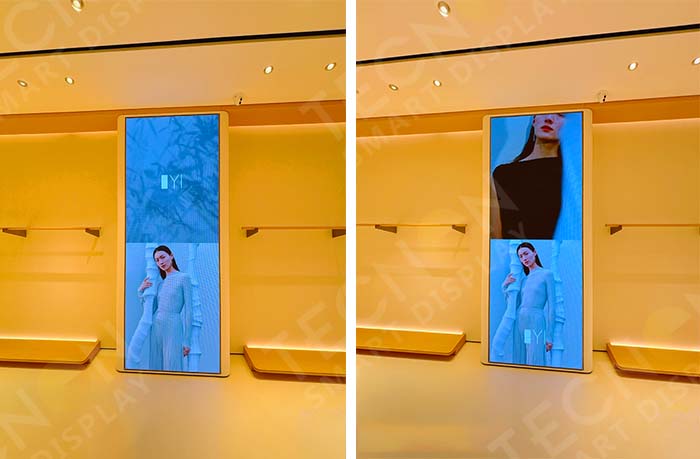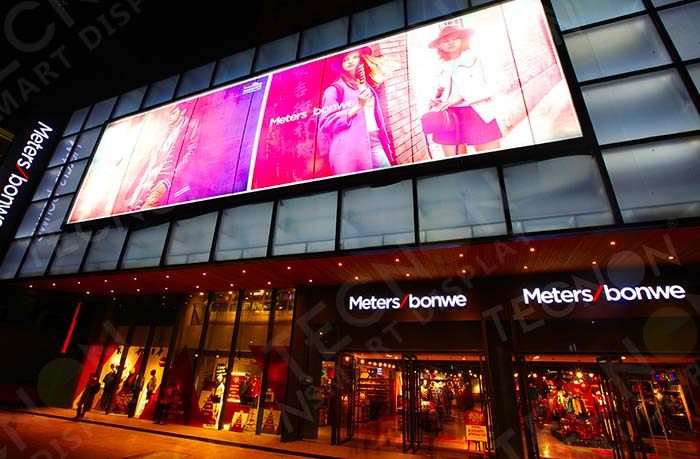1、Introduction
In today’s world, the need for energy-efficient solutions has never been more critical. LED displays have become integral to urban spaces, retail environments, transportation hubs, and more. As cities and businesses focus on reducing their carbon footprint and improving sustainability, energy saving LED screens offer a promising solution. With the growing demand for sustainable display technologies, energy-efficient LED displays are at the forefront of this revolution, providing both economic and environmental benefits.

2、Features and Innovations in Energy-Saving LED Displays
Energy-efficient LED displays are designed to deliver high performance while consuming less power. Several key features and innovations contribute to their energy-saving capabilities.
Low Power Supply Design and Optimized PCB Board
Modern energy saving LED screens use compact power supplies and PCB layouts to reduce energy waste. These designs minimize heat generation and voltage loss, ensuring stable performance with up to 30% lower power consumption.
Advanced Driving IC and Control Systems
High-efficiency driving ICs regulate current flow with precision, cutting unnecessary power usage. Paired with smart control systems, they enable seamless dimming and color calibration, enhancing energy-efficient digital screen performance.
Common Cathode and Co-Negative Technologies
It is advanced methods used in energy-saving LED displays.By reversing traditional current flow, common cathode LED modules reduce energy loss, allowing the display to use less power while maintaining high brightness levels. Co-negative setups further optimize voltage distribution, making these efficient LEDs ideal for large-scale installations.

Dynamic and AI-Based Brightness Adjustment
AI algorithms analyze ambient light conditions in real-time, auto-adjusting screen brightness. This LED display dynamic energy-saving technology ensures optimal visibility while slashing energy use by 40–60%.
Use of Light Sensors that Automatically Adjust the Brightness
Built-in sensors detect environmental lighting, fine-tuning brightness without manual input. This feature is key for energy-saving technologies for LED displays in outdoor settings.
Strong Cooling System
Advanced thermal management, like liquid cooling and heat-dissipating materials, prevents overheating. Cooler screens operate more efficiently, extending lifespan and reducing maintenance costs.
3、Energy Consumption and Performance Comparison
Why LED Screen is Energy Efficient
LED screens are known for their energy efficiency due to the way they generate light. Unlike traditional LCDs that use backlighting, LEDs emit light directly from each individual pixel. This results in less energy consumption, as the display only needs to light up the pixels that are needed to create the image. Additionally, LEDs are more efficient at converting electrical energy into visible light, making them more energy-efficient than other display technologies.
Calculation of Power Consumption vs. LCD and OLED
When comparing power consumption, LED displays significantly outperform LCD and OLED screens. A typical LED display consumes far less power to achieve the same brightness level as an LCD or OLED display. The efficiency of energy-saving LED displays is enhanced by their ability to adjust brightness dynamically, unlike LCD and OLED displays, which are often fixed in terms of power consumption.
LED vs. LCD: An energy-efficient LED screen can consume up to 50% less power than a comparable LCD display. This is mainly because LEDs don’t rely on backlight and instead use a more direct method of producing light.
LED vs. OLED: While OLED displays are known for their superior color quality, they tend to consume more power than LED displays, especially at higher brightness levels. In contrast, energy-efficient LED screens offer a better balance between power consumption and visual performance.
Energy-saving LED screens consume 50% less power than LCDs and 30% less than OLEDs. Their modular design allows partial activation, unlike backlit LCD panels, saving energy in low-use scenarios.

Power Use Calculations
A 100 sq. ft. LED screen uses ~8 kW daily, compared to 15 kW for LCDs. Over a year, this difference can save 2,500 kWh—enough to power a household for months.
Brightness, Efficiency, and Cost Trade-offs
While LED displays are energy-efficient, there is often a trade-off between brightness, efficiency, and cost. Higher brightness typically requires more energy, but energy-saving technologies such as dynamic brightness adjustment can mitigate this issue. Manufacturers continue to innovate in balancing these elements to deliver energy-efficient LED displays that don’t compromise on performance.
4、Environmental and Economic Benefits
Energy-efficient LED displays offer significant benefits in both environmental and economic terms.
Reduction in Power Usage and Carbon Footprint
One of the most significant advantages of energy-saving LED displays is their reduced power usage. By consuming less electricity, these displays help lower the overall energy demand, reducing the strain on power grids. This makes LED displays an essential part of global sustainability efforts. Energy saving LED screens can cut CO2 emissions by 5–10 tons annually per installation, supporting corporate sustainability goals.
Use of Recyclable and Eco-Friendly Materials
Energy-efficient LED displays are often made with recyclable and eco-friendly materials, which reduces waste and environmental impact. Manufacturers are also adopting greener production processes, reducing the use of hazardous substances and increasing the use of sustainable components, such as use recyclable aluminum and PVC-free components, aligning with RoHS and Energy Star certifications.
Lower Installation and Maintenance Costs
LED displays generally require less maintenance than traditional displays, resulting in lower long-term operating costs. Energy-efficient LED displays also have a longer lifespan, reducing the need for frequent replacements. These factors contribute to overall cost savings for businesses and municipalities.
Increased Service Life and ROI
Though initial costs are 20% higher than traditional displays, energy-efficient LED screens last 100,000+ hours, reducing replacements and energy bills by 40%, adding to the financial benefits of using energy-efficient LED displays.
5、Application Scenarios of Energy-Saving LED Screens
Energy-efficient LED displays are being used in various sectors, from advertising to public infrastructure. Here are some of the key application areas:
Advertising and Digital Signage
LED displays are becoming a popular choice for outdoor advertising and digital signage. Whether it’s a billboard or a digital poster, dynamic signage with LED display energy-saving tech offer businesses an eco-friendly way to advertise while reducing electricity costs.

Public Information and Transportation Displays
In transportation hubs like airports, train stations, and bus stops, LED displays are used to provide real-time information to passengers. These displays not only save energy but also ensure that important information is always visible, regardless of outdoor lighting conditions.
Retail and Commercial Spaces
Retailers and commercial spaces are increasingly adopting energy-saving LED displays to enhance the shopping experience while reducing energy consumption. These displays are used for product promotion, interactive signage, and information boards.

Smart Cities and IoT Integration
As cities become smarter, LED displays play a crucial role in smart city infrastructure. Energy-efficient light pole LED screen integrate seamlessly with the Internet of Things (IoT) to provide real-time data to residents and visitors. Whether used for traffic management, public announcements, or energy-saving campaigns, it help cities function more efficiently.
6、Future Trends in Energy-Efficient Displays
The future of energy-efficient LED displays is promising, with ongoing innovations and emerging technologies set to further enhance their capabilities.
AI-Based Smart Energy-Saving Models
Artificial intelligence (AI) is expected to play a significant role in the future of energy-saving LED displays. AI-based models can analyze real-time data to optimize energy usage, adjusting settings dynamically based on factors like time of day, weather conditions, and traffic patterns. These smart energy-saving models promise even greater efficiency and reduced environmental impact.
Renewable Energy Integration for Sustainable Operation
Integrating renewable energy sources like solar power into energy-efficient LED displays is a key trend for the future. This integration allows displays to operate without relying on grid electricity, reducing both energy costs and carbon emissions. Solar-powered LED displays are particularly beneficial in remote locations or outdoor environments.
Energy Storage Solutions for Off-Peak Usage
Energy storage solutions, such as batteries, are being explored as a way to store energy during off-peak hours and use it during peak demand. This technology can help reduce energy costs and increase the sustainability of LED displays by allowing them to run on stored energy during high-demand periods.
Advanced Cooling Systems for Thermal Efficiency
As LED displays continue to evolve, advanced cooling technologies are being developed to ensure they operate at peak efficiency. These cooling systems help manage heat buildup, ensuring that LED displays maintain optimal performance without excessive power consumption.
7、Regulations, Standards, and Market Adoption
Overview of International Energy Efficiency Certifications (RoHS, CE, Energy Star, etc.)
Energy-efficient LED displays are subject to various international standards and certifications, such as RoHS, CE, and Energy Star. These certifications ensure that LED displays meet specific energy efficiency criteria and are safe for use in various environments. Compliance with these standards is crucial for manufacturers and helps build consumer trust in energy-saving products.
Compliance Challenges for Manufacturers
Manufacturers of energy-efficient LED displays must navigate the complex regulatory landscape, ensuring that their products meet the necessary standards for energy efficiency and environmental safety. The cost and time required to meet these regulations can be a challenge, but the benefits of compliance, including access to global markets, outweigh the challenges.
Market Adoption and Consumer Awareness
As the demand for energy-efficient products grows, consumer awareness of the benefits of energy-saving LED displays is increasing. Businesses and municipalities are becoming more aware of the financial and environmental advantages of using energy-efficient LED displays, leading to greater adoption across industries.

8、Case Studies: Real–World Implementation of Energy-Saving LED Screens
Urban Smart City Projects
In smart city projects, energy-efficient LED displays are used to improve public services and enhance urban living. For example, energy-saving LED screens are installed on street poles, in parks, and at transportation hubs to provide real-time information, enhance public safety, and reduce energy consumption.
High-Performance LED Displays in Retail and Advertising
Retailers and advertisers have implemented energy-saving LED displays to attract customers and deliver engaging content while reducing operational costs. These displays are energy-efficient and provide a high return on investment, making them a valuable asset for businesses.
9、Challenges and Limitations of Energy-Saving LED Displays
Balancing High Brightness with Low Power Consumption
One of the ongoing challenges for manufacturers is balancing high brightness levels with energy savings. LED displays need to maintain visibility and impact, especially in outdoor environments, but doing so while conserving energy requires continuous innovation in display technologies.
Cost Barriers for Small Businesses and Municipalities
The upfront cost of energy-saving LED displays can be a barrier for small businesses and municipalities. While the long-term savings outweigh the initial investment, some businesses may need financial support to make the switch to energy-efficient technologies.
Ongoing Research to Enhance Efficiency
Research into new materials and technologies is ongoing to further enhance the energy efficiency of LED displays. Innovations in power supply systems, LED chip technology, and cooling systems are expected to lead to even more efficient and cost-effective displays in the future.
10、Conclusion
Energy-efficient LED displays represent the future of sustainable display technology. With unmatched efficiency, durability, and ROI, they’re a smart choice for eco-conscious projects. As the technology continues to evolve, energy saving LED screens will play an even greater role in reducing environmental impact and providing long-term economic benefits.

Ready to Go Green?
If you’re looking to learn more about how energy-efficient LED displays can benefit your business or project, feel free to reach out to our team for more information!
 Tecnon Smart Display Technology Shenzhen Co., Ltd.
Tecnon Smart Display Technology Shenzhen Co., Ltd.




